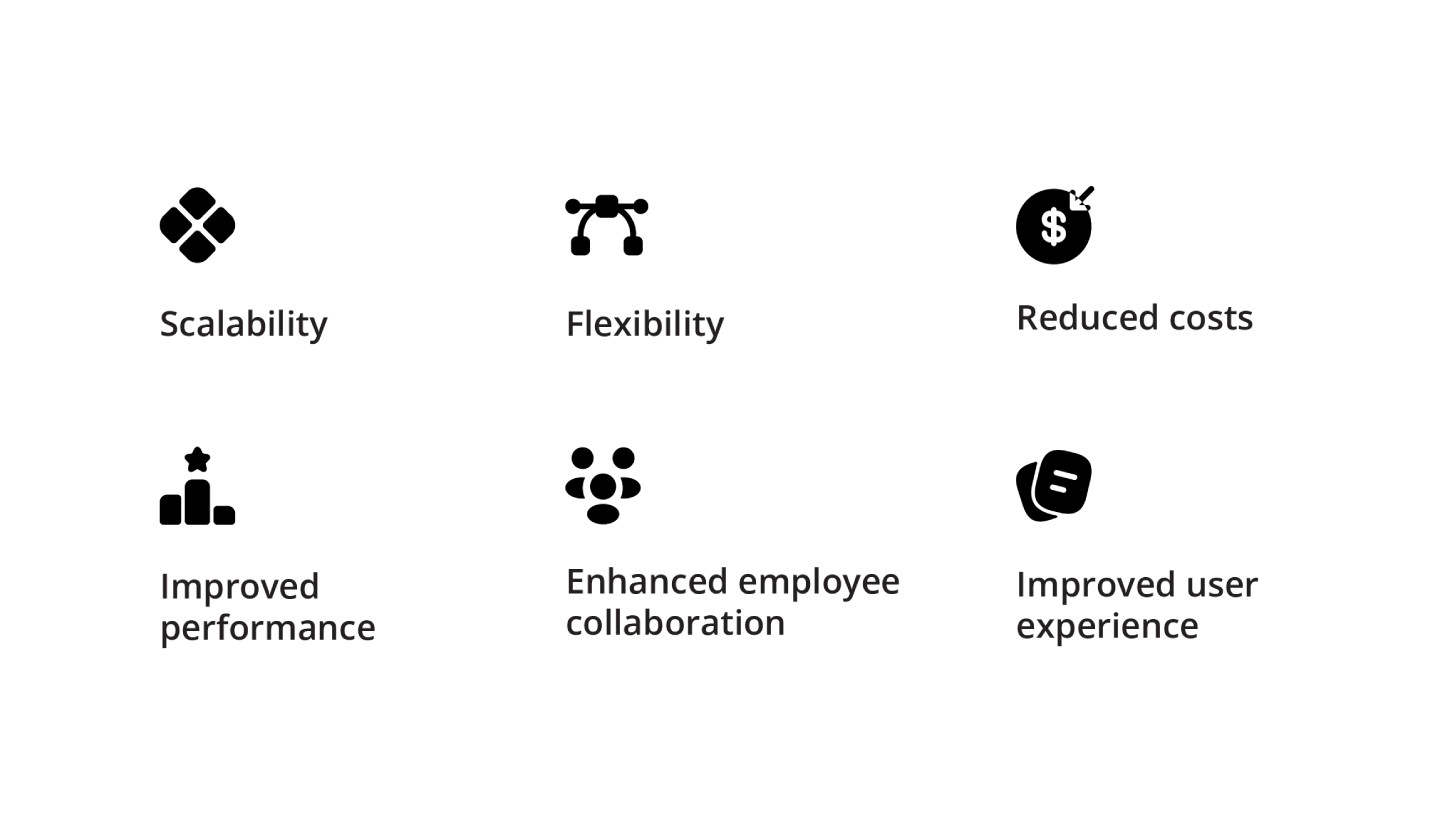But to leverage the cloud’s potential, you must effectively manage the process of data migration in cloud computing.
How, when, and where you move your data requires a full assessment of your goals and existing infrastructure. Based on this assessment, you can determine your migration options and target infrastructure. Then, you can create a detailed transformation roadmap.
That’s all easier said than done. To orient you in this overwhelming process, we’ll teach you the benefits, strategies, and processes of migrating data for cloud computing.
What are the main benefits of migrating to the cloud?

Increased scalability and flexibility
Many businesses start migrating data to the cloud because of its scalability. With an on-premises server, you can only add capacity with new, expensive hardware. In the cloud, you can scale resource consumption based on your needs.
This flexibility means businesses can handle seasonal spikes in demand without maintaining excess infrastructure. When demand increases, you can add resources instantly—even automatically with autoscaling features. When demand decreases, you can scale back just as quickly.
Reduced direct and indirect costs
Since your cloud provider charges you based on usage, moving data to the cloud means you only pay for what you need. Cloud storage also eliminates the indirect costs of on-premises servers, such as maintenance and the need for physical space.
Essentially, you’re outsourcing data storage and processing to a cloud provider. Because they have economies of scale, they can sell to you for less than it would cost to maintain your own infrastructure.
Improved performance and user experience
Cloud providers improve performance in two key ways: low latency and high availability (HA).
Globally distributed data centers decrease latency because content delivery is closer to your end users. And built-in redundancies — techniques like load balancing, data replication, HA architectures, and more — ensure high availability. In short, cloud services are much less likely than on-premises servers to be impacted by local disruptions.
Better performance means end-users get a better experience at the same time as you’re increasing operational efficiency.
Enhanced employee collaboration
Because data migration in cloud computing moves resources to the internet, team members can work together seamlessly regardless of their physical location. But the collaboration benefits extend to in-person employees, too.
It’s much easier to sync and deploy changes in the cloud. This is true whether you’re developing software, editing documents, or updating a project management system. This also makes version control much simpler, reducing confusion and streamlining workflows.
Increased connectivity leads to faster decision-making, more efficient processes, and a more agile work environment.
7 strategies for migrating data to the cloud
Refactor
The refactoring process involves redesigning or modifying an application to leverage cloud-native capabilities. Significant development work is required to break down monolithic infrastructure into microservices, implement new architectures, and adopt cloud-specific services.
Why Refactor?
While this approach requires significant resources upfront, it often yields the greatest long-term benefits. Refactoring enables organizations to capitalize on cloud technology’s advantages fully.
Rehost (“Lift and Shift”)
Rehost, or “Lift and Shift,” involves moving your applications and data from on-premises to the cloud with minimal modifications. This strategy replicates your existing setup in the cloud, though minor adjustments may be necessary for cloud compatibility. In essence, rehosting means replicating your existing setup in a cloud-based infrastructure.
Why Rehost?
Rehosting is the quickest and least complex approach, ideal for speeding up migration and reducing data center costs. Organizations choose this to speed up migration, reduce data center costs, or as an initial step in a phased cloud adoption process. However, rehosting can lead to higher long-term cloud costs if not optimized later.
Relocate
A relocation strategy is similar to rehosting in that both approaches move workloads to the cloud with minimal changes. This approach preserves existing operations and infrastructure in a new cloud environment.
Why Relocate?
Relocating is quick and straightforward, maintaining existing processes and compliance requirements without leveraging cloud-native features.
Replatform (“Lift and Reshape”)
Replatform, or “Lift and Reshape,” moves applications to the cloud platform with some modifications to take advantage of cloud-native features. This method balances the simplicity of rehosting and the complexity of refactoring. During replatforming, organizations make moderate changes, such as switching to a managed database service, to optimize performance and cost efficiency.
Why Replatform?
While this method requires more effort than rehosting, it allows businesses to leverage some cloud benefits without the overhaul required by refactoring.
Repurchase (“Drop and Shop”)
Repurchase, also known as “Drop and Shop,” replaces an existing on-premises application with a cloud-native alternative or SaaS solution. This approach skips the migration of old systems, opting instead for a modern cloud-based application.
Why Repurchase?
While disruptive in the short term, repurchasing offers long-term benefits, such as reduced maintenance costs, improved scalability, and access to modern features.
Retire
Moving all applications to the cloud during a migration is not always necessary. Sometimes, it’s time to retire a resource rather than move it.
Why Retire?
When an application is redundant or obsolete, consider retiring it. Reducing the number of applications you migrate simplifies the process and eliminates unnecessary resources.
Retain
In some cloud migrations, certain applications must be maintained because they aren’t ready to be migrated, can’t be migrated, or don’t need to be migrated, but can’t be retired.
Why Retain?
Retention is a good strategy when an application must remain on-premises for compliance, cost, technical, or other operational reasons or if migrating the application does not benefit businesses.
Steps to create a cloud data migration strategy for your company

Assess and plan the migration
The first step in determining how to migrate data to the cloud is an assessment to identify potential challenges, security concerns, and compatibility issues. This includes evaluating existing systems, applications, and data to determine which elements must be migrated.
Based on this assessment, you develop a detailed migration plan that outlines the strategy, timeline, and resources required for a successful transition. This plan should identify and establish:
- The appropriate cloud model: public, private, or hybrid
- The cloud service providers you want to work with: AWS, Azure, Google Cloud Platform, etc.
- A roadmap for moving workloads with minimal disruption to business operations
Prepare the data
Data preparation sets the foundation for improved data management and facilitates an efficient and secure migration. The data preparation process involves an assessment and organization of the existing data to:
- Identify which data to migrate.
- Determine the required data format for the target cloud environment.
- Classify data based on its security sensitivity and required format.
- Triage redundant or obsolete data for disposal.
Data preparation tasks include data cleansing and validation to ensure accuracy and consistency.
Migrate the data to the cloud
Data migration in cloud computing is the transfer of an organization’s data from on-premises infrastructure to cloud-based systems. Depending on the volume of data and business requirements, the transfer may involve different migration methods, such as batch processing, real-time streaming, or change data capture (CDC). Based on the sensitivity of the data, security measures are implemented before, during, and after the migration to protect information.
After the data is moved, post-migration testing and verification confirm that all data has been accurately transferred and is operational in the new cloud environment. Access controls are enforced to comply with internal and external data security and compliance regulations.
The risks of data migration to the cloud
Data loss or corruption
Cloud migrations are complex, and technical issues or errors can cause permanent data loss. To mitigate these risks, businesses need a skilled migration partner and robust disaster recovery measures.
Security and compliance liabilities
The risk of data breaches is real and can have severe consequences, such as major disruptions, regulatory fines, and reputational damage. Security and data privacy are critical when you move data to the cloud, which introduces new vulnerabilities and access points. Since businesses have less direct control and must rely on the cloud provider’s security protocols, choosing a reputable cloud provider is critical.
Cost
The cloud offers the potential for significant cost-savings, but poorly managed data migration issues in cloud computing increase costs. Without proper governance, monitoring, and strategic use of cloud resources, the potential cost savings of the cloud can be eroded.
Of course, experienced developers who understand how to balance cost, performance, and business requirements can help mitigate this.
Best practices for successful cloud data migration
Find a partner with experience
When embarking on a cloud data migration project, you need a partner with extensive experience. A knowledgeable, skilled partner helps you minimize risk, reduce downtime, and facilitate a migration that meets your requirements and aligns with your goals.
For any provider you evaluate, look for case studies of successful migrations across various industries and cloud platforms. Their track record should demonstrate expertise in all aspects of the migration process, including data security, compliance, and performance optimization.
With an experienced partner, you should expect a comprehensive assessment of your current infrastructure, a tailored data migration to cloud strategy, and ongoing support throughout your transition to the cloud.
Develop a comprehensive migration blueprint
As with any large, complex project, the devil is in the details. So, it’s critical to develop a comprehensive data migration blueprint. This blueprint should outline the entire migration process based on an assessment of:
- The current infrastructure
- The data to be migrated
- The target cloud platform
- Any necessary security and compliance measures
It should also detail the migration strategy, whether it’s a lift-and-shift approach or a more complex re-architecting of applications. The blueprint must account for potential challenges, set clear timelines, assign responsibilities, and establish metrics for measuring success.
By creating a thorough plan, you can minimize disruptions, ensure data integrity, and maximize the benefits of cloud migration.
Conduct a data inventory and classification
A successful cloud data migration begins with understanding exactly what you’re dealing with. This process should include a detailed assessment of:
- All data assets: Identify the full scope of data currently in use.
- Data sensitivity: Classify data based on its level of sensitivity, such as personal, confidential, or public.
- Criticality of data: Determine which data is mission-critical and which is less essential.
- Access requirements: Understand who needs access to what data and when.
This inventory and classification will guide your migration priorities, ensuring that critical and sensitive data is migrated securely and efficiently while less important data can be archived or discarded. It also helps you apply the appropriate security measures and compliance protocols.
By starting with a clear picture of your data landscape, you can streamline the migration process, reduce risks, and ensure your cloud environment is organized and secure from day one.
Opt for a phased migration approach
A phased migration approach is a low-risk strategy for moving your data and applications into a cloud environment.
This method involves moving data in phases, typically starting with less critical, simpler datasets before progressing to more complex or sensitive information. By breaking the migration into manageable chunks, companies can better control the process, identify and address issues early, and minimize disruptions to ongoing operations. Also, as the migration progresses, teams gain experience and refine their processes, which can lead to smoother transitions.
Finally, a phased approach allows for thorough testing and validation at each phase to ensure data integrity and system compatibility.
Do pilot testing
When planning a cloud data migration, starting small is essential to reduce risk. Conducting a pilot test or proof of concept (PoC) allows you to identify potential issues before committing to a full-scale migration. This step involves:
- Selecting a small, non-critical dataset or application: Begin with a portion of your data or an application that, while representative of the broader migration, poses minimal risk to operations.
- Testing the migration process: Apply your planned migration strategy to this pilot to observe its effectiveness and identify any issues.
- Analyzing performance and outcomes: Monitor the pilot closely to assess the performance, uncover any unforeseen challenges, and evaluate the success of the migration process.
The insights gained from the pilot will let you refine your migration strategy, addressing any issues before they impact the broader migration.
Prioritize data security and compliance
Ensuring data security and compliance should be at the forefront of any cloud data migration strategy. During migration, sensitive data is particularly vulnerable to breaches and unauthorized access.
Implement robust security measures such as data encryption for transit and at rest, multi-factor authentication, and strict access controls to safeguard your information throughout the migration process.
Additionally, ensure that your migration plan complies with all relevant regulatory standards and industry-specific regulations, such as GDPR, HIPAA, or PCI DSS. Work closely with your cloud service provider to understand their security protocols and compliance certifications.
Conduct regular security audits and assessments to identify and remediate potential vulnerabilities promptly. By prioritizing data security and compliance, you will protect your organization’s critical assets, maintain trust with your customers, and avoid potential legal and financial repercussions.
Conduct thorough testing and validation
Thorough testing and validation are essential components of a successful cloud data migration. Before, during, and after the migration, perform comprehensive tests to ensure that all data has been accurately and completely transferred and that applications function correctly in the new environment.
Start by creating a detailed testing plan including various test scenarios, such as functionality, performance, and security tests. Involve key stakeholders and end-users in the testing process to gather valuable feedback and identify any issues or discrepancies. Utilize automated testing tools where appropriate to increase efficiency and accuracy.
Post-migration, continuously monitor system performance and conduct regular validations to ensure ongoing reliability and effectiveness. Promptly address any issues to minimize disruption and maintain optimal operational performance.
By conducting diligent testing and validation, you can identify and resolve potential problems early, ensuring a smooth transition to the cloud and maintaining business continuity.
Data modernization case studies: Intellias in action
Data technology assistance for a private aviation company
The client: A luxury jet charter service provider with a global fleet of over 350 aircraft.
The challenge: The company’s data management processes and lack of integration were causing substandard data interpretations. This led to inaccurate financial planning and resource allocation decisions.
The solution: Intellias enhanced ETL processes with Airflow and DBT technologies and developed a new data warehouse using Snowflake-based solution to transform the client’s data management practice.
By integrating internal and 3rd-party solutions, the new system connected analytics from every company function, including finance, marketing, and customer service. This allowed the client to use Tableau-based reporting and dashboards to interpret high-quality data, which facilitated improved decision-making.
The business impact
- Improved operational efficiency and resource utilization
- Up to $24 million saved in excess commodity purchases
- Improved business scalability
- Accurate financial planning and decision-making
‘Lift and Shift’ data migration for a global fintech enterprise
The client: A US-based fintech enterprise providing innovative payment products and services to partner businesses worldwide.
The challenge: The company’s on-premises PostgreSQL data warehouse struggled with performance during peak loads, elevated backup risks, and limitations in supporting business growth.
The solution: Intellias helped plan and manage the company’s migration to a modern cloud data warehouse using AWS Aurora and leveraging AWS Data Migration Service for a no-downtime switch. The migration process included upgrading from PostgreSQL 9.6 to 14.3, allowing the client to process large volumes of unstructured and poorly formatted data effectively.
The business impact
- Improved ability to handle peak system loads
- Reduced risks due to the AWS Shared Responsibility model
- Capability to support a 10TB data warehouse for anticipated company acquisition
Your partners in cloud migration
Migrating your data to the cloud offers compelling benefits, from increased scalability and reduced costs to improved performance and enhanced collaboration. Yet it’s a complex, risky process that requires careful planning and execution.
Partnering with experienced professionals is the best way to mitigate these risks and unlock the benefits of the cloud.
If you’re considering a cloud data migration for your organization, Intellias is well-equipped to provide expert consultation. Our team offers tailored strategies, technologies, and implementation to address your specific migration needs and challenges.


